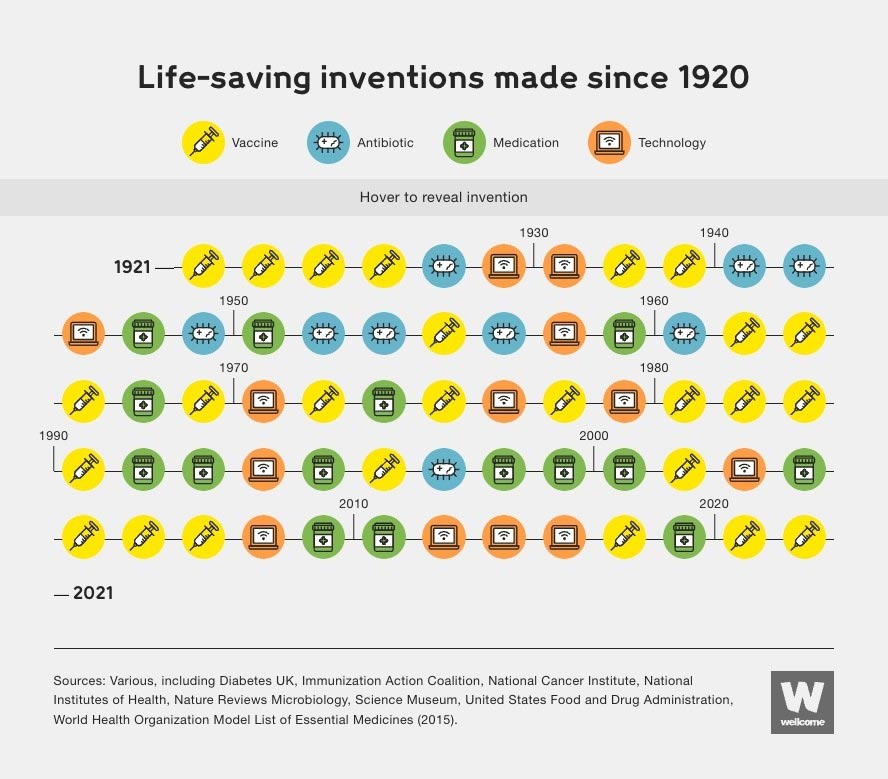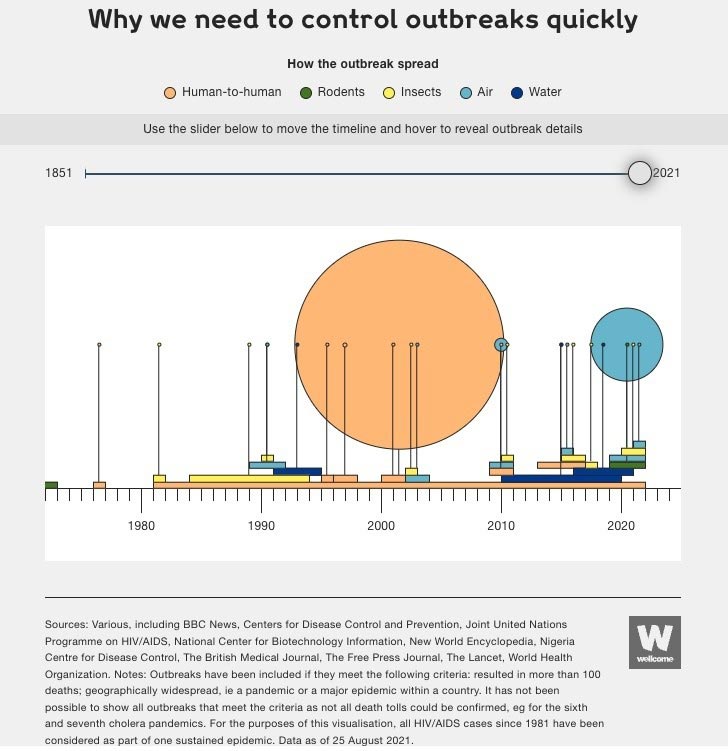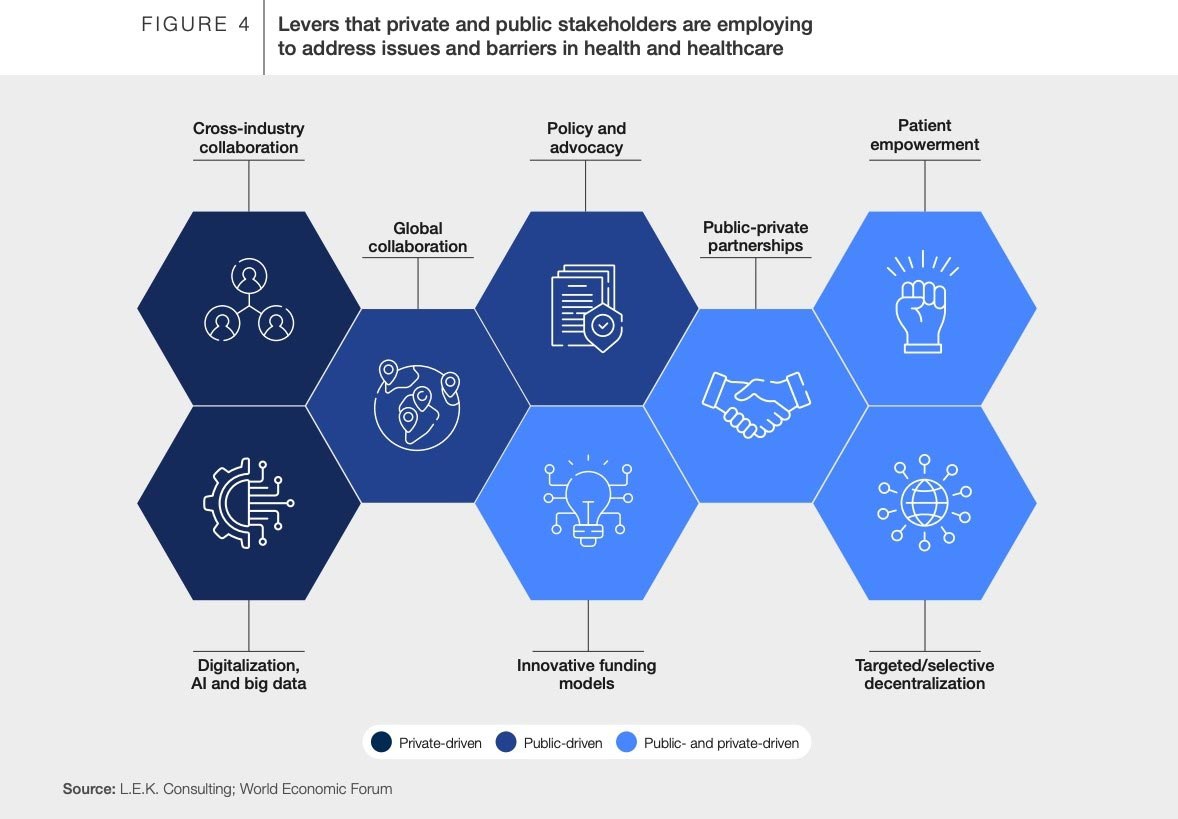From smallpox to COVID: the medical inventions that have seen off infectious diseases over the past century
Infectious diseases have shaped human history. Here are some of the medical innovations that have helped fight the most destructive ones since the 1920s.
- 12 May 2023
- 4 min read
- by World Economic Forum

When in 1897, HG Wells made his Martian invaders in The War of the Worlds succumb to Earthly bacteria, scientists had only just identified the cause of what would become known as the Third Bubonic Plague. And it was spreading around the world. Two decades later, the 1918 flu epidemic (referred to at the time as the 'Spanish Flu') ravaged the globe, causing the death of 45 million people.
It's maybe only natural that Wells chose bacteria to kill off his villains, because infectious diseases have made a deep impact on the development of humanity throughout its history. And they continue to do so - a fact that the COVID-19 pandemic has driven home to all of us.
Wellcome, the health research foundation, has now tracked the scientific innovations of the past 100 years that have helped us combat some of the most destructive infectious diseases.
https://wellcome.org/news/charts-how-science-combatting-infectious-disease

Credit: Wellcome
Vaccines stop infectious diseases in their tracks
Ever since Edward Jenner administered the first modern vaccination - against smallpox - in the late 1700s, vaccines have helped eliminate some of the most infectious diseases. As Wellcome highlights, they have helped improve life expectancy and mortality rates, especially among children, by about 50% in the past 30 years alone.
Today's childhood vaccinations against whooping cough, tetanus and diphtheria all date back to the 1920s, as does the BCG vaccine against tuberculosis. In the 1930s, the first 'flu shot' was developed, and many of us benefit from annual flu shots to this day.
Polio vaccinations followed during the 1950s, drastically reducing infections of what used to be one of the world's most feared diseases. Measles, mumps and rubella came along in the 1960s, before being combined into the MMR vaccine in the 1970s.
Have you read?
More recently, the Ebola and COVID-19 vaccines have shown that vaccinations remain critical to disease control. A vaccination against malaria currently in trials holds the same hope. The ability to react quickly and develop a vaccine for a new pathogen has sped up significantly in the past decade. Technological advances have led to faster, cheaper and easier mass production of vaccines, such as the RNA vaccines against COVID-19.
https://wellcome.org/news/charts-how-science-combatting-infectious-disease

Credit: Wellcome
Antibiotics to fight infection
Alongside vaccinations, antibiotics have served to stem many bacterial infections. The discovery of penicillin in the 1930s led to a wave of innovation and commercialization of antibiotics. They became a panacea for many of the bacterial infections that had curtailed human life since antiquity.
However, antibiotic resistance has been increasing in recent years. This means that the effectiveness of antibiotics is waning and drug-resistant infections are becoming a threat to people's health - again.
Innovative medicines to tackle infectious diseases
Medicines to deal with the impact of infectious diseases have also come on in leaps and bounds over the past century.
From oral rehydration salts for diseases associated with diarrhoea (1960s) to antiretrovirals against HIV/AIDS (1990s) and a range of new treatments against malaria, medication has given hope and extended the lives of many who would previously have been condemned to suffering and death.
Medical technology advances
Technology has not only had a hand in drug discovery, it has also played a key part in the treatment and management of infectious diseases.
Many of the tests and devices we use today have a long history. Indoor residual spraying against malaria was developed in the late 1940s, a rapid diagnostic test for malaria infections came in the 1990s, followed by long-life insecticide-treated mosquito nets.
Similarly, technology innovations have helped in the battle against tuberculosis, including diagnostic tests and the sequencing of the whole tuberculosis genome - which was only achieved in 2017.
Alongside, technologies such as CT and MRI scanners, which emerged in the 1970s, have helped speed diagnoses and treatment.
https://wellcome.org/news/charts-how-science-combatting-infectious-disease

Credit: Wellcome
Collaboration needed to boost scientific discovery
Major infectious diseases such as malaria, Ebola, HIV/AIDS, cholera and tuberculosis still need to be rooted out - not to mention COVID-19.
At the same time, the hunt for the next "Disease X" continues. Disease X is an unknown pathogen - a virus, bacterium or fungus, for example - with the potential to become the next COVID-19.
According to Wellcome, effective research and coordinated global action are critical to preventing and stopping outbreaks in their tracks.
Along similar lines, the World Economic Forum's new report, Global Health and Healthcare Strategic Outlook: Shaping the Future of Health and Healthcare, advocates stronger cross-industry and global collaboration, the use of digital technology, artificial intelligence and big data as well as innovative funding and organizational models such as public-private partnerships.

Credit: World Economic Forum
Written by
Andrea Willige, Senior Writer, Forum Agenda
Website
This article was originally published by the World Economic Forum on 11 May 2023.
More from World Economic Forum
Recommended for you









